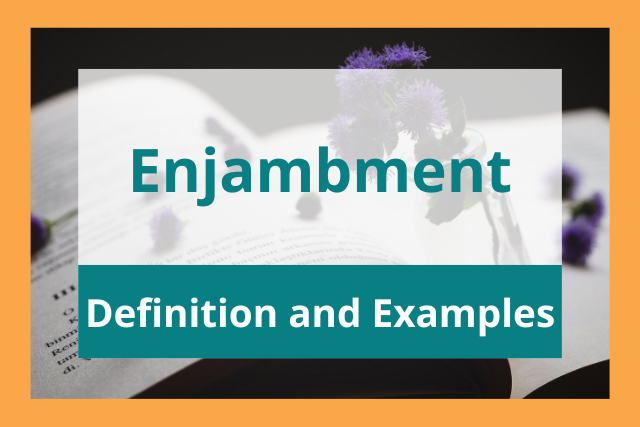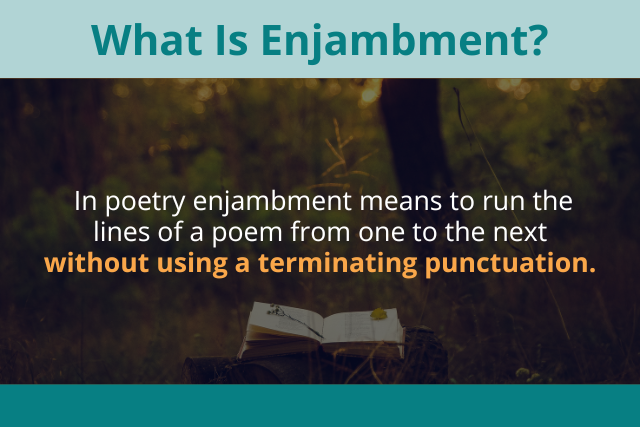
Poets use a range of poetic devices and techniques such as sounds, rhythms, and phrases to elevate their poems and enhance its meaning.
The result? Words that captivate you, taking you along on a journey to a world of the poet’s own design.
Enjambment is just one of the literary devices that can make your writing more engaging and exciting.
Read on to find out more about enjambment and how to identify enjambment example lines in your favorite poems.
Enjambment Definition
Enjambment (pronounced en-jam-ment) is a French word that means “to step over or to put legs across.” In poetry, it means running two or more lines of a poem together without a terminal punctuation mark.
The poet does not complete their thought by the end of a line and instead leaves the reader with a cliffhanger that they can only resolve by going to the next line. In an enjambment, the thought doesn’t end with the line break.
Enjambment creates a sense of drama in a poem as readers are pulled beyond the limitations of a single line. The literary device allows poets to control the pace of their work and subsequently, how it is read by their audience.

Enjambment in Poetry
Poetry lovers normally associate enjambment with 20th century poets like E.E. Cummings and William Carlos Williams.
However, enjambment has a long history, dating back to as early as Homer and even being used in the Hebrew Bible. It was also a very popular technique among Elizabethan poets such as William Shakespeare.
Enjambment Literary Definition
The term as a literary device refers to the practice of running lines of poetry from one to the next using no punctuation to indicate a stop (periods, commas, etc.).
While enjambment is most famously used in poems, it can also be used in songs and other literature. Shakespeare was well known for including them in his plays. Below is an example of enjambment from Shakespeare.
William Shakespeare, Hamlet (1609)
To be, or not to be—that is the question:
Whether ’tis nobler in the mind to suffer
The slings and arrows of outrageous fortune
In this example, the second line is enjambed, with the thought going over into the third line. Notice the thought continues past the line break.
Enjambment Examples
Here are a few examples of enjambment from popular poems.
Example 1: The Waste Land (by T. S. Eliot)
April is the cruellest month, breeding
Lilacs out of the dead land, mixing
Memory and desire, stirring
Dull roots with spring rain.
Winter kept us warm, covering
Earth in forgetful snow, feeding
A little life with dried tubers.
In this extract, all the lines except lines 4 and 7 are enjambed.
Example 2: The Red Wheelbarrow (By William Carlos Williams)
So much depends
upona red wheel
barrowglazed with rain
waterbeside the white
chickens
Williams has used enjambment throughout the entirety of The Red Wheelbarrow.
Example #3: It is a Beauteous Evening (By William Wordsworth)
It is a beauteous Evening, calm and free;
The holy time is quiet as a Nun
Breathless with adoration; the broad sun
Is sinking down in its tranquility;
While there is a semi-colon in the middle of line three, it does not form a terminal punctuation.
Example #4: Endymion (By John Keats)
A thing of beauty is a joy forever:
Its loveliness increases; it will never
Pass into nothingness but still will keep
A bower quiet for us, and asleep
Full of sweet dreams, and health, and quiet breathing.
This opening section of Endymion is a well-known example of using enjambment. The first and last lines are the only lines that use end marks, while all the middle lines are enjambed.
Why Enjambment Is Useful to Writers
Using enjambment can create an elevated experience for writers by adding subtle drama.
It moves the writer to continue reading, since a line in poetry that has been enjambed won’t make sense until you’ve read the line(s) that succeed it. The full meaning of enjambed lines will only become clear by reading further in the poem.
Here are some reasons writers use enjambment:
- To create a sense of suspense—enjambment pulls the reader from one line to the next in a way that piques the reader’s interest. It creates a sense of urgency, forcing them to get to the next line in order to have a full grasp of what the poet is trying to convey.
- Evokes a variety of emotions—as readers try to understand the meaning of the enjambed lines, they can experience a variety of emotions, which makes for a better reading experience.
- To create a sense of mystery—an air of ambiguity is created as readers muse over the lines, forcing them to ask themselves “what does this mean?” The readers are often in for a surprise, as poets can set up one idea in the first line and change that idea in the second line.
- Controls the rhythm and flow—enjambment emphasizes words and shows their importance. It also creates a better flow because of the reduced number of final punctuation marks.
Final Thoughts on Enjambment
Enjambment is a poetic technique that allows a thought to span multiple lines. It has no ending punctuation and allows the poet to manipulate the rhythm of the lines by going against an expected pattern in the poem. Enjambment can make your writing more engaging and exciting.


